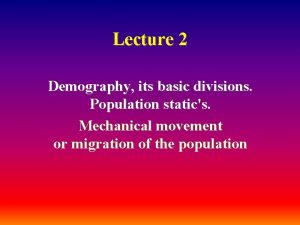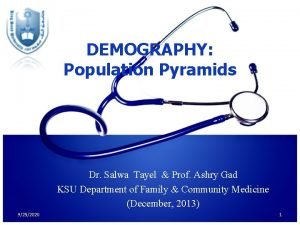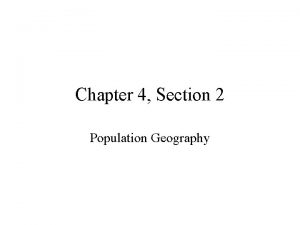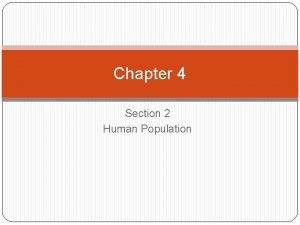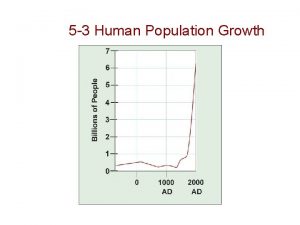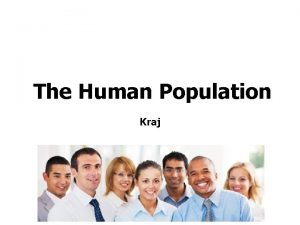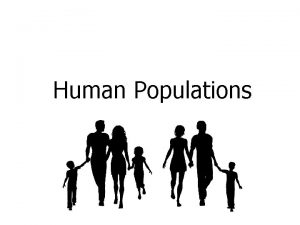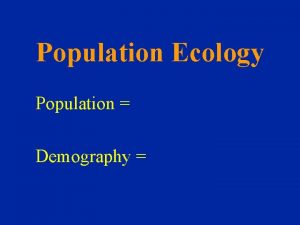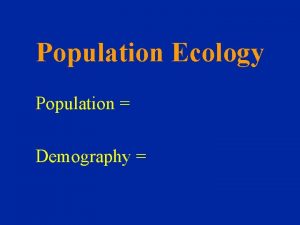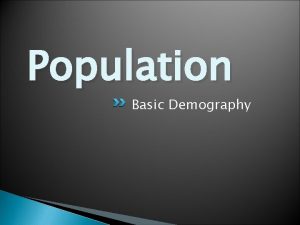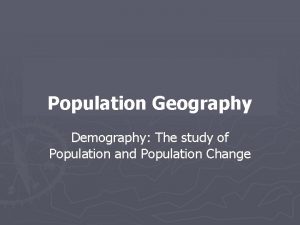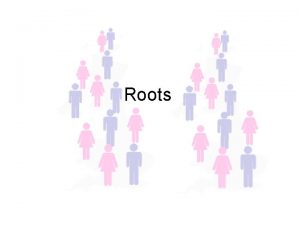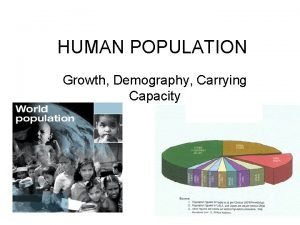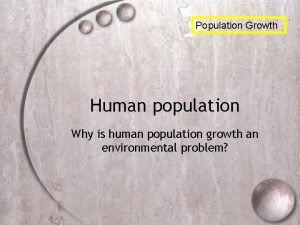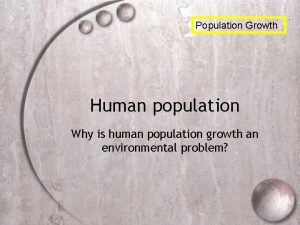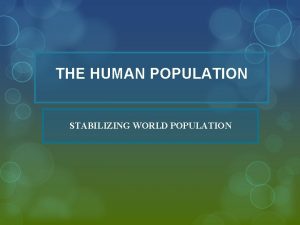POPULATION AP HUMAN GEOGRAPHY UNIT 2 DEMOGRAPHY Demography































- Slides: 31

POPULATION AP HUMAN GEOGRAPHY UNIT 2

DEMOGRAPHY • Demography is the study of population. • How people are distributed based on age, gender, occupation, fertility, health, socio-economic factors, etc. • Why is understanding demographic trends important? • More people are alive now – 7 billion – than historically before. • Population increased in the 2 nd half of the 20 th century at faster rate than before • Almost all population growth is in LDCs • Overpopulation is not a global threat – it is a phenomenon in some regions, but not others.

POPULATION CARTOGRAM

POPULATION CONCENTRATION • Humans are not uniformly distributed across the globe (as illustrated by the cartogram). • We look at population based on concentration and density. • 2/3 of the world’s population is concentrated in 4 regions • East Asia, Southeast Asia, South Asia, Europe • Some similarities: • • Ample water (near oceans or major rivers) Low lying areas Good farmable soil Temperate climate

SPARSELY POPULATED AREAS • Humans avoid clustering in certain physical environments. • • Dry Lands Wet Lands Cold Lands High Lands • Of course there are exceptions to the rule (i. e. Bedouin of the Arabian desert, Quecha peoples of the Andes, Inuit, etc. ) • Places of permanent human settlement are termed the ecumene. • Places considered too harsh for occupancy have diminished over time. • Remember possibilism – we can ADAPT, and have

POPULATION DENSITY • Density can be computed in up to three ways for a place: • Arithmetic Density • Total number of objects in an area • Computation: Divide the population by the land area • Physiological Density • Number of people supported by a unit area of arable (farmable) land • Computation: Divide the population by the arable land area • Agricultural Density • Ratio of the number of farmers to amount of arable land • Computation: Divide the population of farmers by the arable land area

ARITHMETIC

PHYSIOLOGICAL

AGRICULTURAL

NATURAL INCREASE • Crude Birth Rate – number of live birth rates in a year per 1000 people. • Crude Death Rate – number of deaths in a year per 1000 people. • Natural Increase Rate - % by which population grows in a year • Find it by subtracting CDR from CBR after converting both to percentages. • Doubling time - projected amount of time that it will take for population to double • • Resource management Urban planning Economic planning More than 95 percent of the natural increase is clustered in developing countries.


FERTILITY • Number of children born to a population’s women – • Difference between crude fertility rate and total fertility rate (fecundity) – CFR is actual, TFR is potential • Most women do not have 20 children • Social norms, birth control, biological constraints • Social, political, economic and environmental factors affect fertility. • LDC tend to higher TFRs; i. e. , Sub-saharan Africa is greater than 6. 0, less than 1. 9 in Europe.



MORTALITY • Infant Mortality Rate (IMR) • Measure used by geographers to better understand death rates in a society • Defined as the annual number of deaths of infants under one year of age, compared with total live births • Usually expressed per 1, 000 births rather than a percentage • IMR is 5 in developed countries and 80 in sub. Saharan Africa.


WHY IS GLOBAL POPULATION INCREASING? • Developed Countries (MDC) • Lower rates of… • Natural increase • Crude birth • Total fertility • Infant mortality • Developing Countries (LDC) • Higher rates of… • Natural increase • Crude birth • Total fertility • Infant mortality

POPULATION PYRAMIDS • A special bar graph known as a population pyramid can visually display a country’s distinctive population structure. • X-axis • Percent male displayed to the left of zero • Percent female displayed to the right of zero • Y-axis • Age cohorts typically grouped in 5 -year intervals • Youngest displayed at bottom and oldest at top


DEPENDENCY RATIO AND SEX RATIO • Dependency Ratio • Defined as the number of people who are too young or too old to work, compared to the number of people in their productive years. • People aged 0 to 14 and over 65 years old are considered dependents. • Larger dependency ratios imply greater financial burden on the working class. • 85 percent in sub-Saharan Africa, while 47 percent in Europe. • Sex Ratio • Defined as the number of males per 100 females in the population • Developed countries have more females than males, because they tend to live 7 years longer.


THE DEMOGRAPHIC TRANSITION • A model consisting of four stages that helps to explain the rising and falling of natural increase over time in a country. • Historically, no country has ever reverted back to a previous stage. • Thus, the model can be thought to have a beginning, middle, and an end.

THE DEMOGRAPHIC TRANSITION? • Stage 1: Low Growth • Marked by very high birth and death rates. • No long-term natural increase • No country presently is in Stage 1 • Stage 2: High Growth • Marked by rapidly declining death rates and very high birth rates • High natural increase • Europe and North America entered stage 2, as a result of the industrial revolution (~1750). • Africa, Asia, and Latin America entered stage 2 around 1950, as a result of medical revolution-improved medical care.

THE DEMOGRAPHIC TRANSITION? • Stage 3: Moderate Growth • Marked by rapid decline in birth rates and steady decline in death rates • Natural increase is moderate. • Gap between CBR and CDR is narrower in stage 3 countries than stage 2 countries. • Population grows, because CBR is still greater than CDR. • Most European countries and North America transitioned to stage 3, during first half of twentieth century.

THE DEMOGRAPHIC TRANSITION? • Stage 4: Low Growth • Marked by very low birth and death rates • No long-term natural increase and possibly a decrease • Country reaches stage 4 when population gains by CBR are diminished by losses because of CDR. • Condition known as zero population growth (ZPG) • Demographers more precisely define ZPG as the TFR that produces no population change. • Population change results from immigration. • Demographers may eventually ad a 5 th stage for countries in decline.

WHY ARE BIRTHRATES DECLINING ? • Two Successful Strategies for Lowering Birth Rates: • Improving Education and Health Care • Emphasizes improving local economic conditions so that increased wealth is allocated to education and health programs seeking to lower birth rates. • Contraception • More immediate results reaped than previous approach • Met with greater resistance, because it goes against cultural or religious beliefs of some.


THOMAS MALTHUS ON OVERPOPULATION • Theory (1798) • Unchecked population would exceed food supply • Increasing population increases likelihood of famine, disease, and war • Poverty increases • The poor are responsible for population increases, because wealthy are educated and understand this • Poor need to stop having children • Reality • Food production has increased over last 50 years faster than Malthus predicted. • His model predicted world population to quadruple over the course of 50 years. • Not even in India has population growth outpaced food production. • Elitist – hold only poorest responsible

EPIDEMIOLOGIC TRANSITION • Medical researches have identified an epidemiologic transition that focuses on distinct health threats in each stage of the demographic transition. • Stage 1: Pestilence and Famine (High CDR) • Principal cause of death: infectious and parasitic diseases • Ex. black plague (bubonic plague)

EPIDEMIOLOGIC TRANSITION • Stage 2: Receding Pandemic (Rapidly Declining CDR) • Pandemic is a disease that occurs over a wide geographic area and affects a very high proportion of the population. • Factors that reduced spread of disease, during the industrial revolution • Improved sanitation • Improved nutrition • Improved medicine • Famous cholera pandemic in London in mid nineteenth century.

EPIDEMIOLOGIC TRANSITION • Stage 3: Degenerative Diseases (Moderately Declining CDR) • Characterized by… • Decrease in deaths from infectious diseases. • Increase in chronic disorders associated with aging. • Ex. Cardiovascular diseases, Cancer • Stage 4: Delayed Degenerative Diseases (Low but Increasing CDR) • Characterized by… • Deaths caused by cardiovascular diseases and cancer delayed because of modern medicine treatments.
 Hotelling model ap human geography
Hotelling model ap human geography Demographic data definition
Demographic data definition Eugenic population policies definition ap human geography
Eugenic population policies definition ap human geography Frq format ap human geography
Frq format ap human geography 5 themes of geography ap human geography
5 themes of geography ap human geography Stateless nation
Stateless nation Static demography
Static demography Cso business demography
Cso business demography Elements of demography
Elements of demography Difference between a sample and a population
Difference between a sample and a population Components of demography
Components of demography Deforestation antonym
Deforestation antonym Human development index definition ap human geography
Human development index definition ap human geography Ap human
Ap human Folk songs ap human geography
Folk songs ap human geography Newly industrialized countries ap human geography
Newly industrialized countries ap human geography Cultural landscape ap human geography example
Cultural landscape ap human geography example Dot density map definition ap human geography
Dot density map definition ap human geography Narrator
Narrator Ecumene ap human geography
Ecumene ap human geography Flows definition ap human geography unit 1
Flows definition ap human geography unit 1 Mr stepek ap human geo
Mr stepek ap human geo Population ecology section 1 population dynamics answer key
Population ecology section 1 population dynamics answer key Population ecology section 1 population dynamics answer key
Population ecology section 1 population dynamics answer key Population ecology section 1 population dynamics
Population ecology section 1 population dynamics Section 1 population dynamics answer key
Section 1 population dynamics answer key Chapter 4 section 2 population geography
Chapter 4 section 2 population geography Unit 10, unit 10 review tests, unit 10 general test
Unit 10, unit 10 review tests, unit 10 general test Chapter 4 section 2 human population
Chapter 4 section 2 human population Chapter 4 section 2 human population answer key
Chapter 4 section 2 human population answer key Population growth concept map
Population growth concept map 5-3 human population growth
5-3 human population growth






